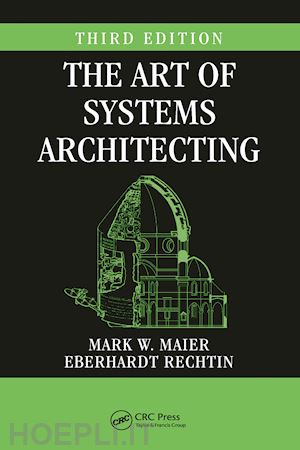Part I: IntroductionA Brief Review of Classical Architecting MethodsChapter 1 Extending the Architecting ParadigmIntroduction: The Classical Architecting ParadigmResponding to ComplexityThe High Rate of Advances in the Computer and Information SciencesThe Foundations of Modern Systems ArchitectingThe Architecture Paradigm SummarizedThe Waterfall Model of Systems AcquisitionSpirals, Increments, and Collaborative AssemblyScopes of ArchitectingChapter 2 Heuristics as ToolsIntroduction: A MetaphorHeuristics as Abstractions of ExperienceSelecting a Personal Kit of Heuristic ToolsUsing HeuristicsA Process Framework for Architecting HeuristicsHeuristics on HeuristicsA Taxonomy of HeuristicsNew DirectionsPart II: New Domains, New InsightsCase Study 1: DC-3The HistoryArchitecture InterpretationThree Story VariationsWas the Boeing 247 Successfully Architected?What Is the "Architecture" of the DC-3?Art Raymond’s PrinciplesChapter 3 Builder-Architected SystemsIntroduction: The Form-First ParadigmTechnological Substitutions within Existing SystemsConsequences of Uncertainty of End PurposeArchitecture and CompetitionReducing the Risks of Uncertainty of End PurposeRisk Management by Intermediate GoalsThe "What Next?" QuandaryControlling the Critical Features of the ArchitectureAbandonment of an Obsolete ArchitectureCreating Innovative TeamsArchitecting "Revolutionary" SystemsSystems Architecting and Basic ResearchHeuristics for Architecting Technology-Driven SystemsCase Study 2: Mass and Lean ProductionIntroductionAn Architectural History of Mass ProductionCottage Industry (1890s to 1910s)Birth of Mass Production (1908–1913)Competition from New Quarters (1920s to 1930s)The Toyota Production System (1940s to 1980s)Metaphor or Vision ChangesCraftsmenA Car for the Masses, or If We Build It, It Will SellCars as FashionThe Supermarket MetaphorThe Toyota WayElements of the Architecture of the Ford Production SystemThe Assembly LineEnterprise DistributionManagement ProcessesQuality Assurance for Distributed ProductionDevotion to Component-Level SimplificationSocial ContractChapter 4 Manufacturing SystemsIntroduction: The Manufacturing DomainManufacturing in ContextArchitectural Innovations in ManufacturingDynamic Manufacturing SystemsLean ProductionFlexible ManufacturingHeuristics for Architecting Manufacturing SystemsCase Study 3: Intelligent Transportation SystemsIntroductionITS ConceptsITS Sociotechnical IssuesWho Is the Client for an Architect?Public or Private?Facts and PerceptionsArchitecture as Shared InvariantsDominance of EconomicsChapter 5 Social SystemsIntroduction: Defining Sociotechnical SystemsPublic ParticipationThe Foundations of Sociotechnical Systems ArchitectingThe Separation of Client and UserSocioeconomic InsightsThe Interaction between the Public and Private SectorsFacts versus Perceptions: An Added TensionHeuristics for Social SystemsCase Study 4: Hierarchical to Layered SystemsBusiness BackgroundMotivation for ChangeThe Layered AlternativeThe Pain of the TransitionResultsChapter 6 Software and Information Technology SystemsIntroduction: The Status of Software ArchitectingSoftware as a System ComponentSystems, Software, and Process ModelsThe Problem of HierarchyThe Role of Architecture in Software-Centered SystemsProgramming Languages, Models, and ExpressionArchitectures, "Unifying" Models, and VisionsDirections in Software ArchitectingExercisesCase Study 5: The Global Positioning SystemThe HistoryThe Origins of GPS: The Foundational ProgramsInertial Navigation and Its LimitsWeapon DeliveryThe Transit ProgramTIMATION621BThe Origin of GPSParkinson and CurrieThe Fateful WeekendThe Long Road to RevolutionThe Timeline to OperationCommercial Markets and the Gulf WarRevolution in the Second GenerationUbiquitous GPSGPS-Guided WeaponsArchitecture InterpretationRight Idea, Right Time, Right PeopleBe Technically Aggressive, But Not SuicidalConsensus without CompromiseArchitecture as InvariantsRevolution through Coupled ChangeChapter 7 Collaborative SystemsIntroduction: Collaboration as a CategoryCollaborative System ExamplesAnalogies for Architecting Collaborative SystemsCollaborative System HeuristicsVariations on the Collaborative ThemeMisclassificationStandards and Collaborative Systems Part III: Models and ModelingIntroduction to Part IIIA Civil Architecture AnalogyGuide to Part IIIChapter 8 Representation Models and Systems ArchitectingIntroduction: Roles, Views, and ModelsRoles of ModelsModels, Viewpoints, and ViewsClassification of Models by ViewConclusionExercisesNotes and ReferencesChapter 9 Design Progression in Systems ArchitectingIntroduction: Architecting Process ComponentsDesign ProgressionIntroduction by ExamplesDesign as the Evolution of ModelsEvaluation Criteria and Heuristic RefinementDesign Concepts for Systems ArchitectureArchitecture and Design DisciplinesChapter 10 Integrated Modeling MethodologiesIntroductionGeneral Integrated ModelsIntegrated Modeling and SoftwareIntegrated Models for Manufacturing SystemsIntegrated Models for Sociotechnical SystemsChapter 11 Architecture FrameworksIntroductionDefining an Architecture FrameworkCurrent Architecture FrameworksResearch DirectionsAdapting Processes to FrameworksConclusionNotes and ReferencesPart IV: The Systems Architecting ProfessionChapter 12 Architecting in Business and GovernmentProblem-System-Program-OrganizationStrategy and Architecture in Business and GovernmentArchitecture of ProgramsStrategic Architecting of ProgramsEnterprise ArchitectureChapter 13 The Political Process and Systems ArchitectingIntroduction: The Political ChallengePolitics as a Design FactorThe First Skill to MasterHeuristics in the Political Process: "The Facts of Life"A Few More Skills to MasterChapter 14 The Professionalization of Systems ArchitectingIntroductionThe Profession of Systems EngineeringSystems Architecting and Systems StandardsThe Origins of Systems StandardsCommercial StandardsCompany StandardsA Summary of Standards Developments, 1950–1995Systems Architecting Graduate EducationCurriculum DesignAdvanced Study in Systems ArchitectingProfessional Societies and PublicationsConclusion: An Assessment of the ProfessionNotes and ReferencesAppendix A: Heuristics for Systems-Level ArchitectingIntroduction: Organizing the ListHeuristic Tool ListExercisesNotes and ReferencesAppendix B: Reference Texts Suggested for Institutional LibrariesArchitecting BackgroundManagementModelingSpecialty AreasSoftwareSystems SciencesSystems ThinkingAppendix C: On Defining Architecture and Other TermsDefining "Architecture"Models, Viewpoints, and ViewsReferenceGlossaryAuthor IndexSubject Index











